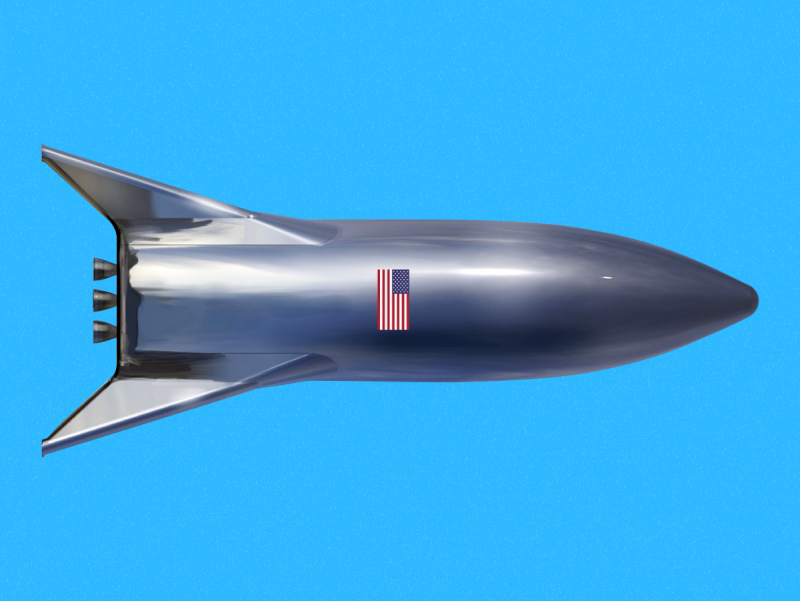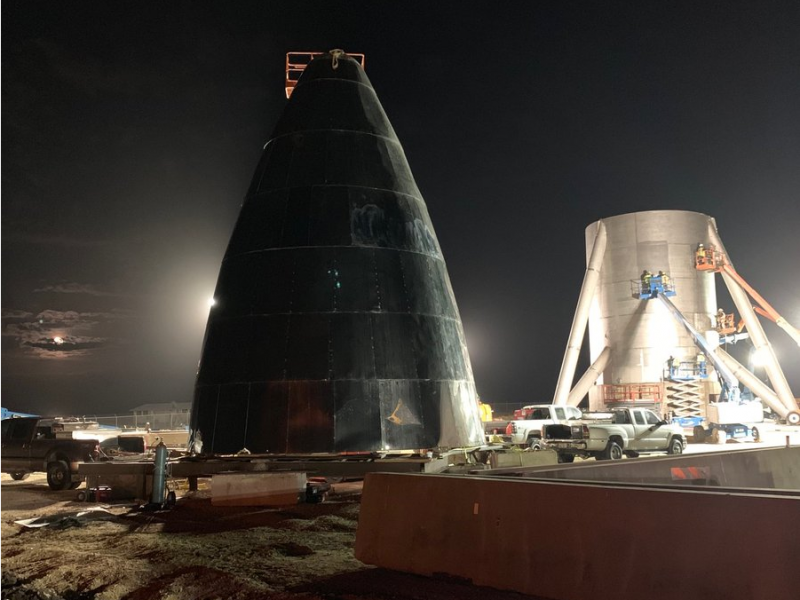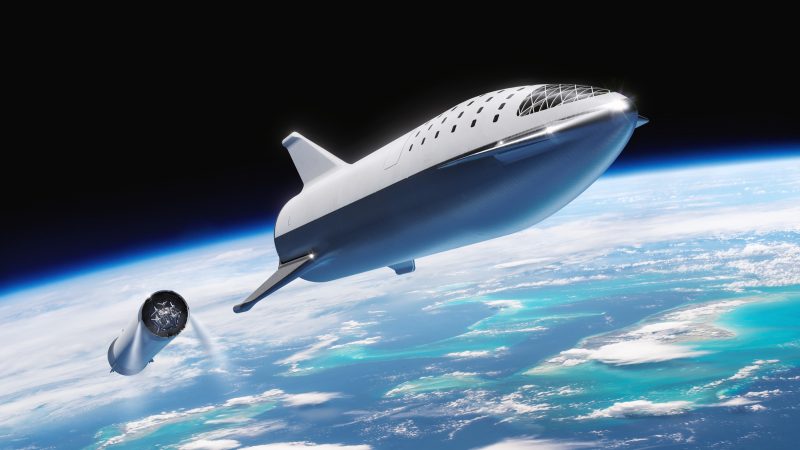- Elon Musk has shared an illustration and a photograph of a SpaceX steel rocket ship with a mirror-like finish.
- This week, SpaceX finished building the vehicle, which Musk called the “test hopper.”
- The test hopper is a squat version of a full-scale Starship: a spaceship that’s being designed to send people to Mars.
- Musk said the test hopper could launch in Texas in four to eight weeks, or nearly a year ahead of schedule.
Last week, Elon Musk shared an eye-catching rendering of a stainless-steel rocket ship. Then last night, he debuted an almost identical image – a real one this time – complete with a person in a spacesuit for scale.
The initial futuristic image was an illustration created by SpaceX, Musk’s rocket company. However, the company has worked feverishly to build the real-life prototype of the vehicle in southern Texas.
“Starship test flight rocket just finished assembly at the @SpaceX Texas launch site,” Musk tweeted on Thursday. “This is an actual picture, not a rendering.”
Musk and Gwynne Shotwell, the president and chief operating officer of SpaceX, most often call the ship the “test hopper” because it’s not designed to launch into orbit around Earth. Instead, the somewhat crude and windowless ship will rocket on “hops” that go no more than about 16,400 feet in the air, according to Federal Communications Commission documents.
It's a critical experimental vehicle whose successes (or failures) will inform how SpaceX works toward a full-scale, orbit-ready prototype of Starship: a roughly 18-story spaceship designed to one day ferry up to 100 people and 150 tons of cargo to Mars.
Musk revealed on Thursday night that SpaceX plans to build a taller, orbit-capable version "around June" of this year. He said that rocketship would have "thicker skins (won't wrinkle) & a smoothly curving nose section."

A full-scale Starship is scheduled to launch people for the first time in 2023, and Musk previously said that "operational Starships would [obviously] have windows, etc."
The first fully crewed mission is being bankrolled for an undisclosed sum by the Japanese billionaire Yusaku Maezawa, who plans to pick eight artists as crew members for a flight around the moon.
Musk has said he hopes to launch the first crews to Mars in the mid-2020s, perhaps as early as 2024, to arrive at the red planet in 2025.
The evolution of Musk and SpaceX's 'Tintin' test ship
During most of 2018, Musk and Shotwell said repeatedly that the test hopper wouldn't make its first flight until late 2019.
But when asked January 5 on Twitter about the test hopper's first flight, Musk said Saturday that SpaceX was "aiming for 4 weeks, which probably means 8 weeks, due to unforeseen issues."
Either way, that's a major jump in the launch schedule - one that coincides with a recent influx of half a billion dollars.
Musk announced in late December that SpaceX was indeed building the test hopper at its lesser-known launch site in Boca Chica, at the southernmost tip of Texas.
He also released a photo of the test hopper coming together:

Musk's confirmation and picture came after a flurry of photos appeared in the forums of NASASpaceFlight.com, where some dedicated followers of SpaceX congregate to chat about the rocket company's latest activities and share information.
The photos, taken by locals in Boca Chica, appeared to show the mythical test hopper being constructed nearly a year ahead of schedule. Musk later said the main parts were being made in Los Angeles and shipped to the semi-remote site for assembly.
Read more: Where SpaceX's most important locations are and what they do
The latest batch of local images shows workers and cranes assembling sections of the test hopper in plain sight of an access road.
#BocaChicaTEXAS sunrise this morning. #BFSBuild #FogTweet 📷: Maria Pointer pic.twitter.com/WB5cUCZZtI
— Cowboy Dan (@CowboyDanPaasch) January 5, 2019
The vehicle doesn't have a seamless finish but it's not supposed to look perfect. In fact, there is a decent chance that it may fail or explode, as is common during early test launches and has happened to many early SpaceX creations.
Musk has described Starship as a "Tintin" rocket, referring to the famous 20th-century Belgian comics series (which features a two-part space-exploration story).
"I love the 'Tintin' rocket design, so I kind of wanted to bias it towards that," he said during a press conference in September. "If in doubt, go with 'Tintin.'"
From carbon fiber to stainless steel that looks like 'liquid silver'

The choice of polished stainless steel is a major shift from what Musk called his "final iteration" of the rocket's design.
In September, Musk revealed design updates for his two-part Mars launch system, called the Big Falcon Rocket. The Starship that Musk unveiled then was set to be about 30 feet wide and 180 feet tall, and sit atop a roughly 219-foot-tall rocket booster that Musk now calls Super Heavy. Both parts were supposed to be made primarily of carbon-fiber composites, which can be much lighter yet many times as strong as steel alloys.
Experts in materials science and aerospace interviewed by Business Insider expressed some reservations about the choice of carbon fiber for the spaceship, given the punishing environment of space and the difficulty in repairing carbon-fiber parts on Earth, let alone in space or on another planet.
Super Heavy may yet be built mostly out of carbon fiber, since it won't reach orbit and will instead land back on or near its launchpad for reuse. But it appears Musk and his engineering team are now committed to using a stainless-steel alloy to make Starship.
Musk said SpaceX's newly developed Raptor engines, which will power the vehicle, would be made of an in-house "superalloy" called SX500. He has also suggested that the final steel body of Starship will "look like liquid silver" and act as its own heat sink - most likely without protective thermal tiles, as NASA's space shuttle used - during the blazing-hot reentry into Earth's or Mars' atmosphere.
"I will do a full technical presentation of Starship after the test vehicle we're building in Texas flies, so hopefully March/April," Musk tweeted on December 22.
This story has been updated. It was originally published on January 8, 2018.

